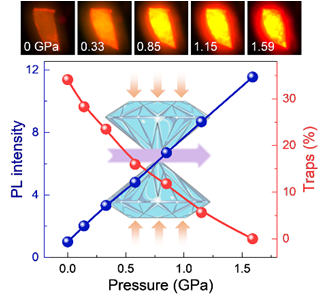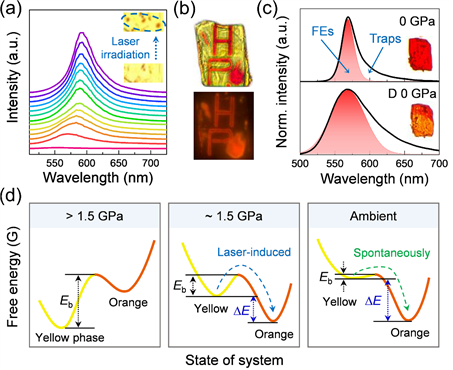Pressure suppresses carrier trapping in 2D halide perovskite - Drs. Wenge Yang & Dr. Xujie Lü
JULY 17, 2020
Two-dimensional (2D) organic-inorganic halide perovskites are emerging materials for photovoltaic and optoelectronic applications due to their unique physical properties and a high degree of tunability. Despite impressive advances, challenges remain, including unsatisfactory performance and a vague understanding of their structure-property relationships. Addressing these challenges requires more suitable material systems and advanced in situ characterization methods.
An international team led by Dr. Xujie Lü and Dr. Wenge Yang from the Center for High Pressure Science and Technology Advanced Research (HPSTAR) discovered that lattice compression under a mild pressure considerably suppresses the carrier trapping of a 2D perovskite (HA)2(GA)Pb2I7, leading to significantly enhanced emission. Intriguingly, a new phase obtained after pressure-treatment possesses a higher crystallographic symmetry, fewer trap states, and enhanced PL intensity. The findings were recently published in Angew. Chem. Int. Ed.

Figure 1. Fluorescence micrographs during compression and the PL intensity and contribution of the trapped states emission as a function of pressure.
Lattice compression through hydrostatic pressure is an effective way to tune the structural and optical properties of two-dimensional (2D) halide perovskites - a new class of emerging materials for photovoltaic and light-emitting applications. However, few examples exhibit improved photoluminescence (PL) performance of 2D perovskites upon compression, and the structure-property relationship remains unclear.
In this work, the team used pressure to modulate a recently developed 2D perovskite (HA)2(GA)Pb2I7, whose structure features an enormous cage previously unattainable. This affords a rare opportunity to understand the structure-property relationship and explore emergent phenomena. Impressively, a remarkable 12-fold PL enhancement was achieved under a mild pressure within 1.6 GPa. The underlying mechanism was systematically investigated by in situ structural, spectroscopic, and theoretical analyses. The lattice contraction leads to phonon hardening that considerably reduces the exciton-phonon interaction and, thus, enlarges the potential barrier for carrier trapping. Therefore, the photogenerated carriers can barely form the trapped states, and the nonradiative recombination pathway is primarily blocked, resulting in an enhanced emission from the free excitons.

Figure 2. (a) Evolution of the PL spectra over time at around 1.5 GPa (during decompression). (b) Optical and fluorescence images of the laser-irradiated sample at 1.5 GPa with an “HP” pattern drawn on the surface. (c) The fitted PL spectra before and after the pressure treatments. (d) Schematic illustration of the energetic variations and photophysical processes during decompression.
Interestingly, for the first time, they revealed an irreversible and anomalous process during decompression, obtaining a yellow, non-luminescent, amorphous phase of (HA)2(GA)Pb2I7 with a higher bandgap. The emission can be triggered and dramatically increased under laser irradiation when the pressure was released to 1.5 GPa, accompanied by a color change from yellow to orange. Based on this observation, they used the laser beam to draw an “HP” pattern on the yellow sample surface in the DAC chamber. When the pressure was released entirely, the amorphous yellow phase could spontaneously transform into a new orange phase with enhanced PL by over 100% compared with the pristine sample. Further structural characterization and spectra analysis reveals that the new phase possesses a higher crystallographic symmetry and less carrier trapping.
By using pressure to engineer the highly-distorted 2D halide perovskite, this work provides fresh insights into the structure-property relationships of perovskites and also enables the discovery of new high-performance materials through pressure-induced phase transitions.
层状二维卤化物钙钛矿由于独特的结构和优异的光电特性,在太阳能电池和发光二极管等领域均展现出广阔的应用前景。然而,其光电性能仍不能满足器件应用的要求,其结构与物性的内在关系也尚未得到很好的认识。近日,由北京高压科学研究中心吕旭杰、杨文革研究员和美国威斯康辛麦迪逊大学金松教授等组成的国际合作团队通过选择具有较大晶格畸变的二维钙钛矿(HA)2(GA)Pb2I7系统研究了其构效关系,发现该材料在较低压力下展现出显著的荧光增强,结构物性原位表征结合理论分析表明压力抑制了激子缺陷态的产生,大幅减小了非辐射复合途径。此外,在泄压过程中发现了新的黄色非晶相,当压力完全释放后,黄色非晶相会自发地转变为橙色相,其发光效率较压力处理前的样品提升了100%。该研究表明,高压研究不仅可以加深对卤化物钙钛矿中结构与物性关系的了解,而且为探索具有优异性能的新材料提供了新途径。相关结果以“Pressure-suppressed carrier trapping leads to enhanced emission in two-dimensional perovskite (HA)2(GA)Pb2I7”为题发表在《德国应用化学》(Angew. Chem. Int. Ed.)上。
